All of us encounter push notifications in our everyday lives. These notifications appear on both Mobile & Desktop. Today, people are most active through mobiles; therefore, it becomes crucial to building those plans and strategies that can increase mobile engagement.
Mobile applications’ progress doesn’t completely rely on its essential components or an app development company’s production process and how well they have marketed and succeeded in retaining its users. Partnering with a specialized Flutter app development company can also play a crucial role in ensuring the application’s success through effective use of this powerful framework.
Even the most modest of characteristics can make a huge difference – and usually, they are the ones who are less noticed, like mobile push notifications.
Let’s move forward to know more about mobile push notifications.
Contents
What Exactly are Mobile Push Notifications?
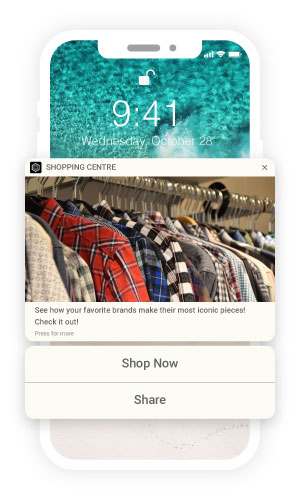
Likewise, web push notifications and mobile push notifications also send messages to customers’ mobile from your app that they have downloaded on their Phones.
If they are permitted to push messages, you can send them notifications about product updates, offers, discounts about important features, or some functionality that demands the user’s attention.
In a nutshell, push notification enables companies to deliver messages that help customers, add value, and hold their interest in your application. Engaging customers through push notifications is a skill in itself, as it requires a great strategy.
But keep in mind that too much indulgence will drive away the consumers. Furthermore, any web app that can be turned into a mobile application will be favoured more by the users – As smartphones are more go-to devices to do necessary tasks. Mobile app development services can help you create these seamless experiences.
You have to keep in mind that it is important to understand how mobile push notifications work on iOS and Android.
- iOS– It doesn’t allow brands to send push notifications until the customer manually permits us to receive them.

- Android– As for Android users, the working system automatically opt-in for push notifications until the user manually opts out.

It would be useful to further research the push notification functions and their consequences before diving into your application strategy. Either way, the capability of mobile push notifications shouldn’t be undervalued, as it gives an application or the brand so many benefits.
Some of them are discussed below in detail to give you an insight into the results mobile push notifications provide.
Advantages of Mobile Push Notifications
The advantages may be many, but how you execute your strategies is what it finally comes down to.
1. Retention of More Customers
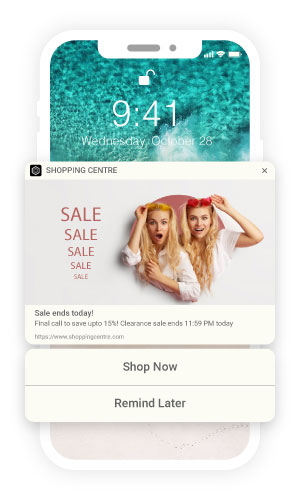
Think like a user for a few seconds and question yourself about the times when you have opened most of your apps on your smartphone? The response might be several times, while they consider up your mobile’s memory far longer than they were made use of.
So how to ensure that your mobile app doesn’t follow the same way of abonnement? Well, by coming up with ideas to engage your customer base and retain them. It is where you can make utilization of push notifications.
According to the stats, 90% of the downloaded apps are opened only once, while barely 16% will check an app more than twice.
The download rate, though, begs to differ. According to Statista, mobile usage and app download rate have boosted exponentially from 2017 to 2018 and are expected to rise in the coming years.
So there is a higher chance of your application reviewing a good number of downloads, hypothetically. Now all you have to do is to handle customer retention.
Curating appealing, informational, particular, emotional, and alluring push messages can do miracles. But keep in mind that you should not overindulge.
2. Drive Conversion
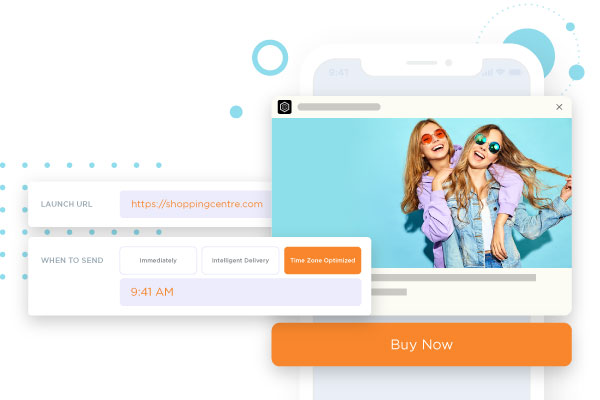
Real-time mobile push notifications are a great way to grab your users’ attention and give an urgent call-to-action, which may trigger prompt action from the user, like acquiring your application. But, whether they make the purchase is another story altogether.
What are Real-Time Mobile Push Notifications?
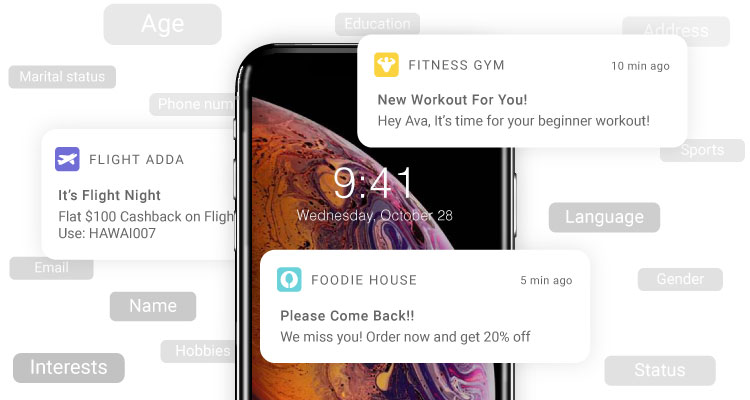
Suppose you are not aware of the terminology and messages that the customer can receive even offline. It is an excellent approach to keep the users notified and involved with many aspects of your application.
Research shows that you can enhance conversion rates by sharing intelligent and behavioural-based mobile push notifications four times.
Consider them as personalized messages. You segment your subscribers into particular boxes according to their intercommunication actions with your app, interests, location, and other tailored aspects corresponding with your app’s goals.
Then, you build mobile push notifications according to the specified groups. It is what segmented push messaging is about, with a proven track record of being more powerful than other types.
So strategize, aim, and hit send!
Boost User Engagement

Might it seem tricky with mobile push notifications? The trick here is that you have to make a balance and avoid trouble. If you succeed in finding a good frequency (the number of times you send notifications) joined with engaging content to push – you are good to go.
Research shows that users receiving less than five notifications per week lead to lessening opting-out of push notifications.
These statistics show that when the push notification is performed right on mobile devices, it can produce desirable results, improving user engagement.
Keep in mind that you are tapping into a device that people are mostly on, so diverting them and creating nuisance through irrelevant notifications can affect your application’s credibility.
Mobile Push Notification Strategy
Now, mobile users in the U.S. have approx 50+ apps on their phones, so it becomes challenging to generate a flow where an app becomes a daily habit. Using multiple apps daily is simply impossible.
When users are occupied with so many apps installed on their smartphones, iOS and Android push notifications can further pull them back to an app. Utilizing behaviour-based triggers and personalization in notifications can be a powerful way to prompt users to log in and perform specific actions that give value.
No matter how much work you put into creating a fantastic native mobile app. It would help if you had an effective re-engagement strategy in place to keep users interested and maximize their potential.
Asking for Mobile Push Permission
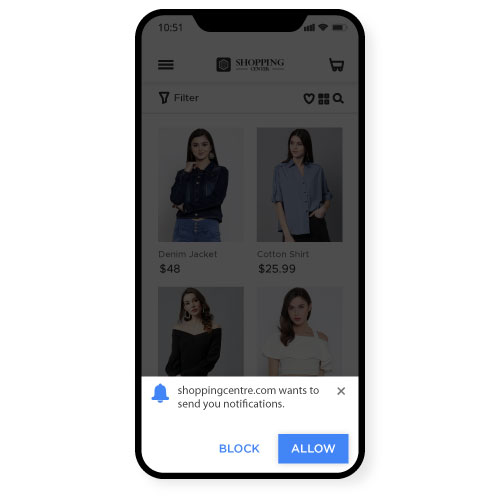
On mobile, small communications can greatly affect the customer’s experience, comfort, and trust. Therefore, one thing you should focus on, in particular, is how to ask iOS users for approval to send mobile push notifications (as I have stated above, Android devices don’t urge users for mobile push permissions).
Asking for approval is your first step and the fundamental requirement of your mobile push notification strategy to determine whether a customer can experience your app to the fullest.
The worst scenario here could be the situation where the user denies permission to push messages at the system level. Once a user rejects permission, changing the decision is much more challenging. In an iOS app, setting push permissions back takes five steps.
Even if your mobile app gets fitted in the low push opt-in rates category. You can enhance your mobile push enablement rate. The study reveals that you can determine user opt-in rates with complete onboarding strategies.
The popular process for asking mobile permission is commonly like this:
- A user downloads a mobile app.
- A user starts a mobile app for the first time.
And the app is instantly popping iOS dialogs with all permissions requests.
It’s not a recommended tactic unless your mobile app is a well-known and trusted brand. App users are more inclined to opt-in to mobile push notifications when they completely understand your app’s value and how mobile push messages will help them.
Make Sure to:
- Teach users about your software
- Present your mobile app’s best features
- Explain the importance of opting in to receive mobile push messages
Knowledge may not be sufficient to maximize your mobile push enablement rate. Another effective approach is to: Urge users to consent to send the first mobile push notification when a trigger point occurs. So they know the reason and purpose for receiving them.
Since you only own just one chance to ask for mobile push permission properly. It’s best to use pre-permission dialogues – this involves asking for approval in your U.I. prior to your mobile app triggering the official iOS dialogue.
Showing your permission information first can further increase opt-in rates at the system level. We’d suggest conducting an A/B test to see what best works for you.
If a user picks “Notify me” on the pre-ask page, you can feel safer encouraging them on an official permission page. But if a user selects “No,” you can wait until the user spends more time encountering and obtaining value from the app.
When starting with a new mobile push campaign. It might be important not to deliver it to all your customers at once. Test with small segments first to determine what works and optimize your messaging/maximize user opt-ins.
Best Practices to Estimate the Performance of Mobile Push Notifications
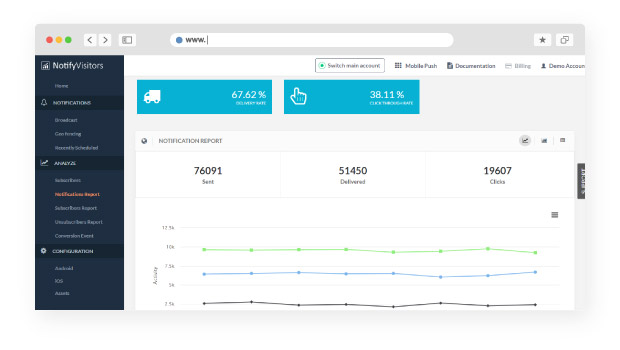
Since you are aware of the best way to ask your users for permission. It’s time to learn the method that will measure your strategy’s performance and assess its success?
The progress of mobile push campaigns is based on four metrics:
- Uninstall / Opt-out Rates
- Opt-in Rates
- Open Rates
- Mobile Engagement
Use these metrics to observe positive user engagement and associate it with the opt-out volume.
1. Uninstall Rate and Opt-out Rates
While doing calculations it always prioritizes uninstalls and notification opt-out rates as it affects your long-term engagement and tells user retention. These two metrics show how efficient your content is and how it influences user experience.
While making changes to your opt-in messaging and journey, make sure you monitor your results closely to act whenever there is a negative trend or fluctuation.
2. Open Rates
Open rates are simple to check. It’s very similar to your email open rates. You can calculate the number of opens against the total volume of notifications sent, involving dismisses. Due to iOS using an opt-in model vs. Android’s opt-out permission model, you will likely see much lower open rates on Android.
3. Opt-in Rate
It is the percentage of people that download your app and opt in to get mobile push notifications.
4. Mobile Engagement Rates
Then, assess actions that are taken, and the engagement linked to your notifications. Try to identify a fixed window of time after the mobile push notification is sent.
Mobile Engagement is calculated as an average number of sessions push recipients performed within the first week of getting the push notification.
Conclusion
These are the benefits and ways through which you get success with mobile push notifications. It is important to be acquainted with the benefits and useful strategies and mobile push notifications. Once you are furnished with the necessary knowledge, go ahead and form a plan to make sure your customers start joining your mobile app and converting them into purchases.
FAQ’s
1. What are mobile push notifications?
Mobile push notifications are short messages sent to a customer’s mobile by apps that they have downloaded on it. They appear in the top portion or lock screen of a mobile device.
2. Why do businesses send mobile push notifications?
Brands and businesses send mobile push notifications to deliver messages that add value, help customers, and engage them with their apps. For instance, to announce discounts, product updates, changes in functionality and features, etc.
3. What are the advantages of mobile push notifications?
If done rightly, mobile push notification marketing can bring about a lot of benefits to businesses. These ultimately boost user engagement, ensure customer retention, and drive conversions.

























 Email
Email SMS
SMS Whatsapp
Whatsapp Web Push
Web Push App Push
App Push Popups
Popups Channel A/B Testing
Channel A/B Testing  Control groups Analysis
Control groups Analysis Frequency Capping
Frequency Capping Funnel Analysis
Funnel Analysis Cohort Analysis
Cohort Analysis RFM Analysis
RFM Analysis Signup Forms
Signup Forms Surveys
Surveys NPS
NPS Landing pages personalization
Landing pages personalization  Website A/B Testing
Website A/B Testing  PWA/TWA
PWA/TWA Heatmaps
Heatmaps Session Recording
Session Recording Wix
Wix Shopify
Shopify Magento
Magento Woocommerce
Woocommerce eCommerce D2C
eCommerce D2C  Mutual Funds
Mutual Funds Insurance
Insurance Lending
Lending  Recipes
Recipes  Product Updates
Product Updates App Marketplace
App Marketplace Academy
Academy

